Who'll win the U.S. elections? A social listening study

Remember when everyone was complaining about how horrible 2016 was and wanted it to end? Well, I bet 2020 can compete for the title of “The Worst Year of Our Lifetime So Far”. And one thing that these two have in common is the presidential elections in the U.S.
Now, I’m not suggesting that the world is currently going through the pandemic AND social, economic, and political unrest because of some curse placed on the White House (even though there’s been plenty of curses). However, given the influence of the U.S. on the world’s politics and economy at large, it would be silly to argue that presidential elections are not a big deal. Wherever you live, the outcome of these elections will affect you.
People’s political views affect a lot of the decisions they make, including buying decisions. People want to support companies that support their values. For example, Progressive Shopper, a browser extension shows you which political party the brand supports. It has already been downloaded more than 20 000 times!

We at Awario just couldn’t pass on the opportunity to use the power of social listening analysis to predict the outcome of these elections. Previously, we tried to predict who will be the main democratic candidate — you can check how successful we were in this blog post.
This time, we examined the conversations around the two main political parties and two presidential candidates to see who has a better chance of winning the U.S. elections according to social media.
We used our social listening tool Awario to analyze online data sourced from social media and the web for the last four months (March - June 2020). In this analysis, we focused on the number of mentions, sentiment, demographic data, and topics associated with our keywords.
Democrats vs republicans
Before we analyze what people say about the candidates, let’s look at the conversation around the two main political parties first. Many Americans vote based on their party affiliations rather than a preference for a specific candidate. These affiliations may even run through families and are typically associated with certain states and demographics.
That’s why we wanted to look into the conversations around the two parties, and not just the presidential candidates. We monitored the hashtags specifically indicating voting intentions in order to find conversations relevant to the upcoming elections such as #VoteBlue, #votedemocrat, #VoteTrumpOut2020, #votered, #redwave, and #Trump2020. All in all, we monitored 22 hashtags in total.
First, let’s see who gets more attention online: republicans or democrats. By looking at the share of voice, we can see which party is talked about the most on the Internet. Here we focused on the mentions coming from the U.S. since we wanted to examine the opinions of the electoral base who might be voting in the upcoming elections. The data came from three sources: Twitter, Facebook, and YouTube.
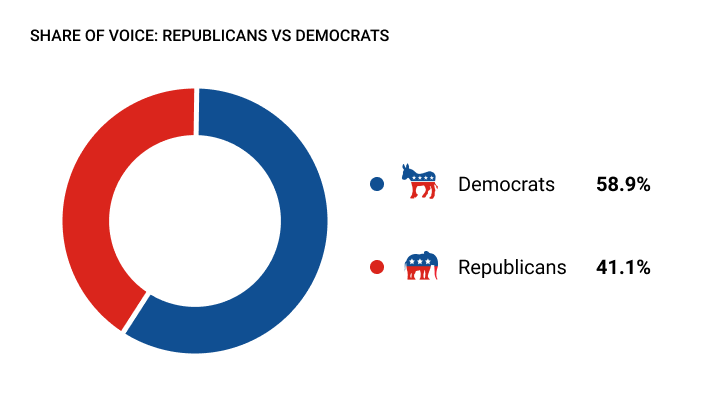
As you see, the Democrats win when it comes to the number of mentions. Their hashtags are used around 43% more often than those of the Republican party. However, the number of mentions is not the most telling metric when it comes to political support — after all, people can talk a lot about you simply to express their disapproval. To see how much support the parties are actually getting, let’s look at the sentiment.
For each party, we counted the net sentiment, i.e. the share of positive vs negative mentions. The formula is the following:

And once again, it seems like social media users favor the Democrats.
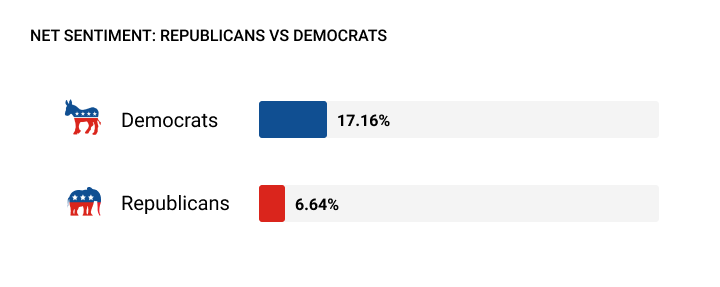
While both values are positive, which means that the number of positive mentions is higher than the number of negative ones, the blue party is undoubtedly winning.
As you might know, the American electoral system greatly depends on the voting results by individual states. It’s common to differentiate between blue and red states, i.e. the states which usually support either democratic or republican candidates in the elections.
We were curious to see how the voting stats compare to the social listening data. That’s why we broke down the number of mentions by states to see which of them favor the donkey, and which - the elephant.
Here's the map that shows red and blue states based on the voting results in the last four elections.
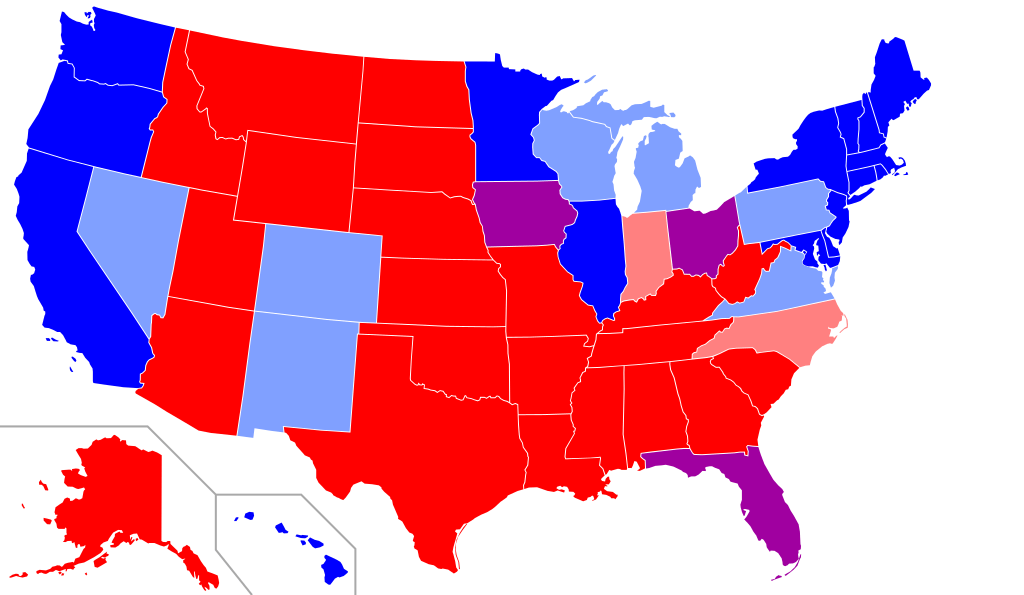
-
Red states carried by the Republicans in all four elections.
-
Light red states carried by the Republicans in three of the four elections.
-
Purple states carried by each party twice in the four elections.
-
Light blue states carried by the Democrats in three of the four elections.
-
Blue states carried by the Democrats in all four elections.
And now let’s take a look at the number of social media mentions by state: the states that have more democratic mentions are blue, and the states that have more republican mentions are red.
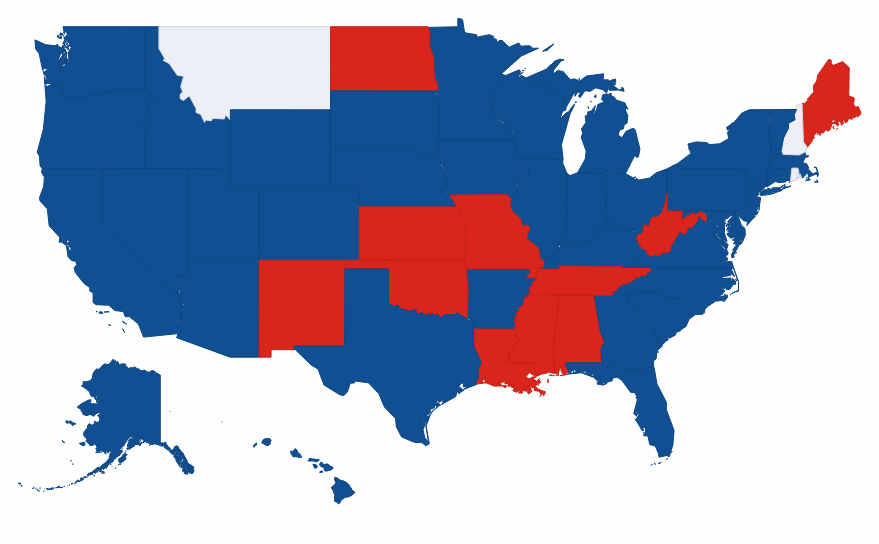
As you see, the maps are quite different: even in the reddest states such as Texas, the democrats win by 152 mentions, which is admittedly not a huge number but still makes it a blue state. The only state that usually votes blue, but has more Republican supporters on social media is Maine. The blank states are the states that have the same amount of mentions of the Dems and the Reps.
Of course, since the Dems have a larger share of voice it was expected that they would have more mentions in more states, but the overwhelming majority of blue states was quite surprising. The hypothesis I have is that the Democratic Party proponents are more active on social media and that’s why they win when it comes to social data.
Now let’s look at what topics are the most prominent in the political debate. By looking at the common topic cloud for the mentions of the Democratic and Republican parties, we can determine which issues worry voters the most.
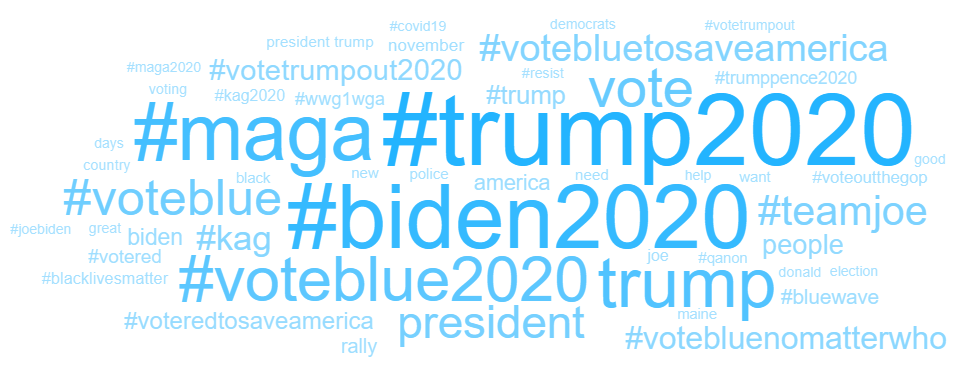
Unsurprisingly, the biggest hashtags are the ones expressing support for the parties. But, if we take a closer look at the Topic cloud, two hashtags stand out: #covid19 with 2,831 mentions and #blacklivesmatter with 4,334 mentions.
Indeed, the country's response to coronavirus and the protests caused by police brutality against black people are the two issues that have been on everyone’s minds, news, and social media feeds lately. Even we at Awario covered both of these topics. We did a social listening study on racial and ethnic slurs in America in this blog post, and analyzed the mentions of COVID-19 here.
You can also notice that there are some hashtags supporting the Democrats that actually mention the Republican party. I’m talking about such hashtags as #voteTrumpout and #voteoutthegop. If you’ve been following the Dem’s election campaign at all, you know that they put a lot of weight on standing up to the current president and kicking him out of the White House, so that explains the anti-republican hashtags.
When we look at the gender of social media users talking about the two parties, we also notice something interesting.

While the shares of men and women talking about the Democrats are pretty equal, the Republican party has a bit more mentions from men which coincides with the voting results as supported by Pew Research Center’s analysis. Could it be because of the Rep’s conservative politics around abortion? You can see our breakdown of pro-life and pro-choice hashtags in this study and decide for yourself!
If we look at the influencers in the conversation, we notice that while the Republican party is greatly represented in the media, the Democrats are more popular with celebrities.
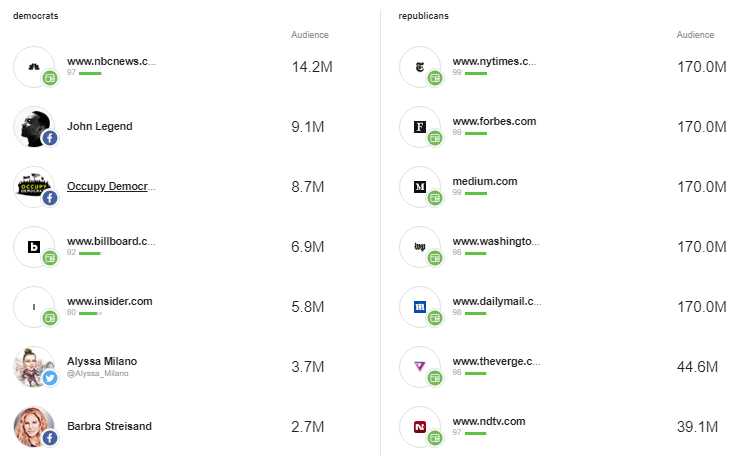
After looking at the individual mentions, it became clear that a lot of buzz was generated by a fundraising event that featured John Legend, Barbra Streisand, Jay Leno, and others. The Democrats know the power of social media influencers!

However, when it comes to presidential elections, the candidates are the deciding factor for most people. To answer the question "Who will win the U.S. elections 2020?", let’s look at the social listening data around the two main candidates.
Democratic and Republican presidential candidates
Even though neither the Democratic nor the Republican National Convention has taken place yet, we already have the two main candidates for the presidential post: Donald Trump from the Republican party and Joe Biden from the Democrats.
Interestingly enough, there are many more mentions around the candidates than around the parties which once again reminds us that the election outcomes greatly depend on the candidates: so let’s see how social media talks about them.
Once again we examined the data coming from the U.S. from Twitter, Facebook, and YouTube for the last 3 months. Since Donald Trump is the current president, looking at the share of voice can be quite misleading: obviously he is mentioned more often. And being such a controversial political figure, not all these mentions are positive— so let’s look at the net sentiment.

I know I said that not all mentions of Trump are favorable, but looking at the net sentiment, he is actually more liked than the Democratic candidate. Admittedly, both candidates are not exactly adored by social media users, but Biden’s net sentiment managed to hit negative digits, which suggests that he’s more disliked than liked. What’s curious and a bit amusing is that the most influential negative mentions of Joe Biden come from… Donald Trump.
Could it indicate that the fact that the current president already has so much attention and reach will contribute to him winning the elections? Perhaps it’s true. To get a certain answer to this question and to the question we pose in the title, let’s look at the data for each candidate.
Donald Trump
Firstly, since we are talking about sentiment, let’s look at the net sentiment of Donald Trump’s mentions by state
It was clear from the low sentiment score that there won’t be a lot of green states, so the fact that the map is almost entirely red doesn’t surprise me.
| Place | 5 states with the highest net sentiment | 5 states with the lowest net sentiment |
|---|---|---|
| 1 | New Hampshire | Puerto Rico |
| 2 | Montana | Alaska |
| 3 | South Dakota | New Mexico |
| 4 | Maine | Vermont |
| 5 | North Dakota | Connecticut |
There is really no unifying feature among those top 5, but it’s unsurprising that Puerto Rico leads the Trump hate parade, since the president’s response to the hurricane that hit the territory was criticized widely.
Now that we know how Americans feel about their current and possibly future president, let’s see what they think about him.
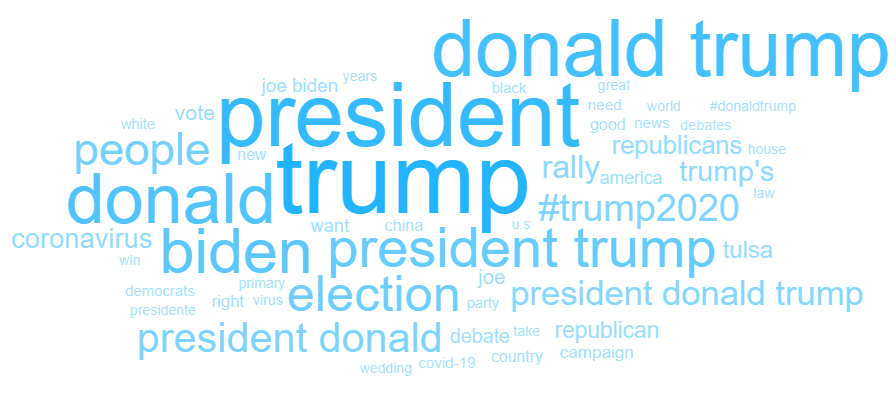
So one of the most noticeable topics that is not directly related to the presidential campaign is coronavirus (2,513 mentions). The measures taken by the president to protect the nation are commonly criticized on social media.
We can also notice the words black (1,295 mentions) and white (1,352 mentions) indicating the topic of racial inequality that’s important to the voters. Another, perhaps unexpected topic that draws attention is China — it’s probably the country the president mentions most often.
The demographics align with the data on the Republicans, with more men talking about Trump than women. That’s not surprising considering Trump’s past objectifying comments about women.

Joe Biden
As with the previous candidate, let’s look at the sentiment map first: which states like the Democratic candidate most and least.
Since Biden's average net sentiment is lower than Trump's, it was expected that his map will also look like 50 shades of red with the rare splashes of green color. The states that like and dislike Joe Biden the most are:
| Place | 5 states with the highest net sentiment | 5 states with the lowest net sentiment |
|---|---|---|
| 1 | Montana | Nebraska |
| 2 | Oregon | New Hampshire |
| 3 | Utah | Delaware |
| 4 | Rhode Island | North Dakota |
| 5 | South Carolina | Kentucky |
Considering the fact that Joe spent most of his childhood in Delaware, that should be pretty hurtful for him.
Maybe Biden’s Topic cloud will give us an idea why people don’t like him that much?
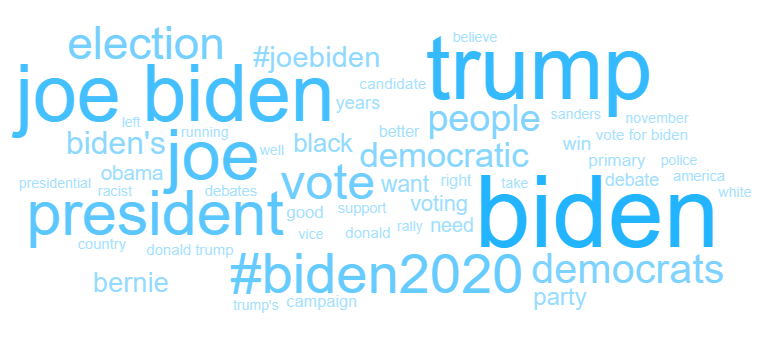
The first thing that draws attention is that Trump’s name is almost as prominent as Biden’s. In the conversations about the Democratic candidate, Donald Trump was mentioned 20,335 times. As I mentioned above, one of the main points of the Dem’s election campaign this year is to “resist” Donald Trump, no wonder the voters talk about him so much.

Another name that comes up a lot is the runner-up for the Democratic nominee Bernie Sanders (3,708 mentions). Considering the fact that Sanders dropped out of the presidential race in April, the fact that he’s still generating buzz doesn’t look good for Biden — maybe people would prefer a different Democratic nominee.
The third prominent topic is racial inequality characterized by the words black (2,936 mentions) and racist (1,588). It was surprising to see the word racist come up in Biden’s Topic cloud but not Trump’s. One theory I have for the reason why Biden might be more criticized for racist views than Donald Trump is that Trump supporters don’t really care about racism that much, so they are not going to call him out.

The demographic stats were even more surprising.

While the gender breakdown of the conversation around the Democratic party is pretty equal, when it comes to discussing Joe Biden, we have an overwhelming male majority. Perhaps democratic women wanted to see another woman as the presidential candidate and once Elizabeth Warren dropped out of the race, lost their enthusiasm for the candidate? Or maybe it’s the rape allegations against Biden that turned them off.
Who will win the U.S. elections 2020?
Of course, any answer to this question should be taken with a grain of salt: the political situation in the U.S. and worldwide is extremely volatile and the faith of the elections themselves during the epidemic is unclear. But, if we look at the social listening data, we can see that while the Democratic party undoubtedly has more support, the presidential candidate they are nominating lacks this kind of ardent support. Moreover, their platform is built on getting rid of Donald Trump, which might not be enough for the voters — people want to see what you’re bringing as well.
Our social listening analysis does not look good for Joe Biden, but the Dems still have time to turn this election around in their favor. If they fail to do this, it’s likely that Donald Trump will stay the American president for another four years.













